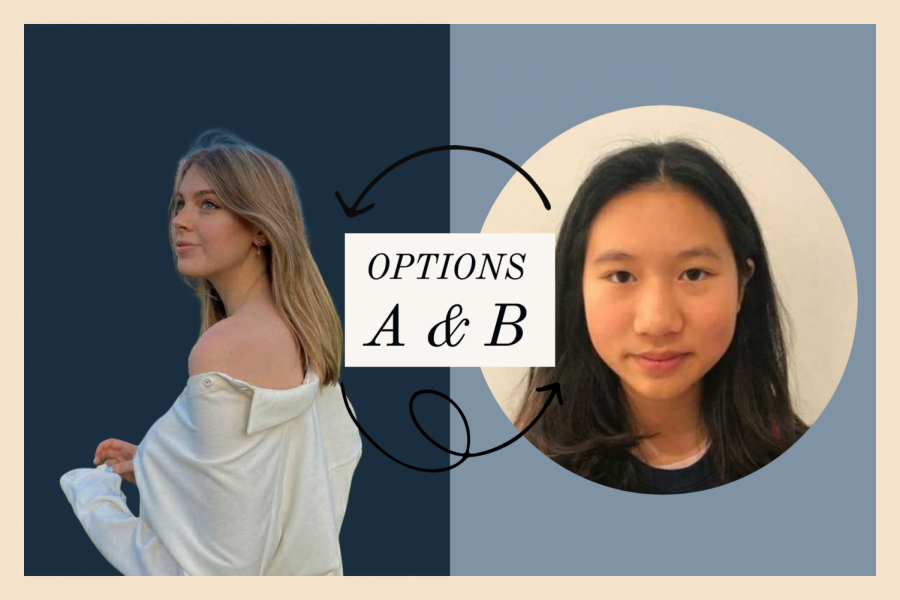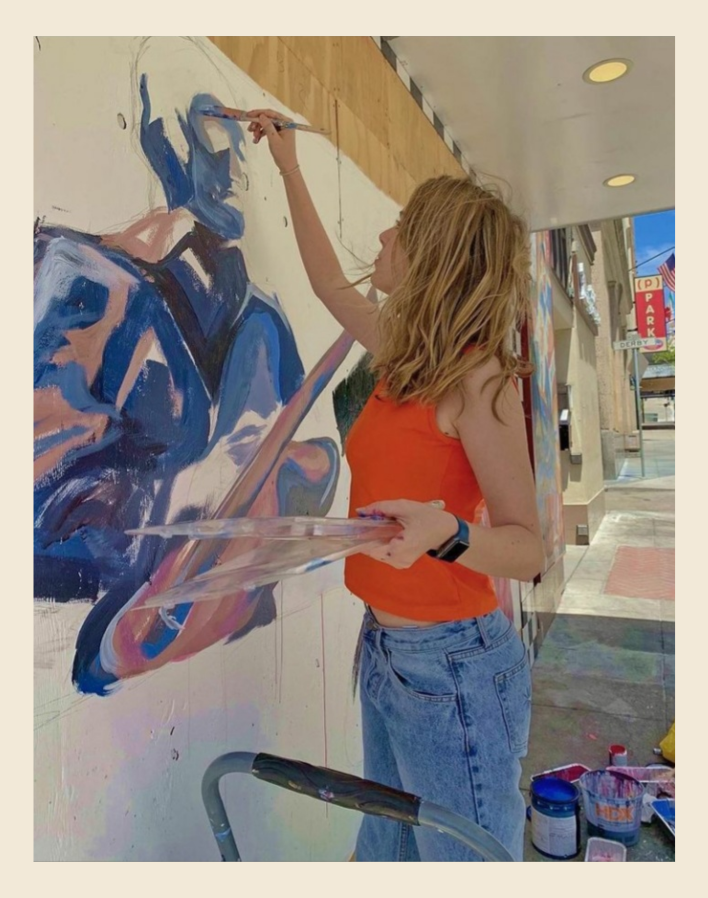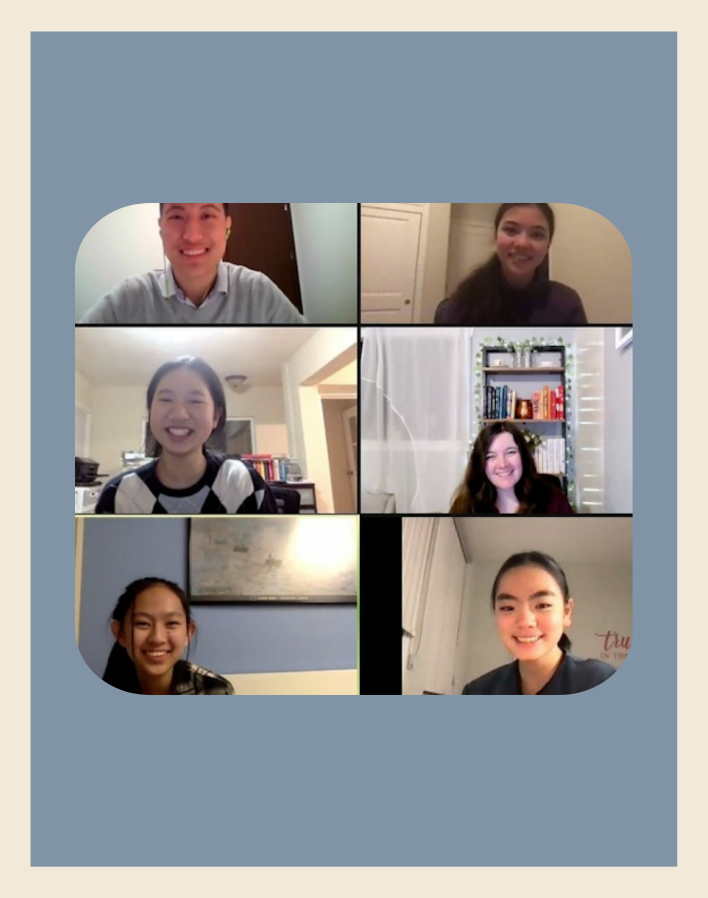Courtesy Maya Amit and Sarah Su
When MVLA students were offered another opportunity to choose between the two remote learning models, Options A and B, for the second semester of the school year, all but 45 students chose to stay put in their current option. Senior Maya Amit and sophomore Sarah Su decided to make the switch, sharing their reflections on their experiences with the two learning models with The Talon.
Option A or Option B? Meet two students who made the switch!
February 28, 2021
Last December, Mountain View–Los Altos students were given a second opportunity to choose between two remote learning models to participate in for the upcoming semester. Option A offered a remote model taught and paced by MVLA teachers with the potential for in-person learning when safety regulations permit. Option B, on the other hand, offered a student-paced model utilizing online platforms like Edgenuity and UC Scout that would allow students to stay in online-learning regardless of safety regulations. The Talon interviewed two students who opted to switch options halfway through the 2020–21 school year in order to explore the advantages and disadvantages of each option from a student perspective.
Maya Amit — Option A to Option B
Senior Maya Amit paints an original mural in Union Square, San Francisco, alongside other local art installations.
A dedicated artist, tutor and self-described “workaholic,” senior Maya Amit chose to switch from Option A to Option B after a difficult first semester. Like most of her peers, Maya initially selected Option A in the summer because she was unacquainted with Option B and unsure of the differences in curriculum and rigor.
“With Option B, I didn’t know who the teachers were, what the platform was like, none of that,” Maya said. “Everyone else was doing Option A, so it just felt safer, like the more normal route.”
Over time, though, Maya began to realize that Option A wasn’t meeting her academic and social needs as well as she thought. The hours spent in front of the screen felt overwhelming and didn’t replicate the meaningful peer interactions she experienced at school before the pandemic. And with an immunocompromised family member in the household, Maya knew that she wouldn’t be able to physically return to school through Option A even if the administration gradually expanded in-person learning.
With those realizations in mind, Maya enrolled in Option B when the opportunity came around in early December. She became one of only 39 Option A students who transitioned to the student-paced option.
“Even though I am school-oriented and a hard worker, Option A really wasn’t working for me in regard to my mental health,” Maya said. “For me, Option B became the safer option because it’s always constant regardless of what’s happening with the COVID-19 situation or the School Board’s decisions.”
So far, Maya has not once regretted her decision. Her new schedule gives her ample free time to pursue other interests while allowing her to maintain academic rigor.
Under Option A, a typical day for Maya might have included four to five hours of Zoom lessons followed by an equal amount of time doing homework. Now, her self-paced schoolwork is limited to a total of around six hours per day.
“It’s been so much easier to balance my time,” Maya said. “I have time to tutor in art and enjoy hobbies like running. Before, my mind would be occupied by school for 12 hours of the day. Now, I can just wake up when I decide to start school, sit in front of the computer and do it. I have the discipline to do it all at once, and maybe a little bit extra at night if I feel like it.”
Maya was also pleasantly surprised by Option B’s quality of learning, particularly with regard to its pre-recorded lectures. In fact, after a month of self-paced instruction, she believes she’s become a better learner due to the new lesson format.
“With pre-recorded videos, all the social anxiety that comes with being on Zoom is removed, which I find really, really helpful,” Maya said. “In Option A, you might be too tired to pay attention or too scared to ask questions in a live lecture, but now I feel like I can take my time to really understand the content.”
Going in, Maya knew that her decision to switch options would come with some caveats. Since she’s in the second semester of her senior year, Maya recognized that switching to Option B would mean the decisive end of any hope for spending in-person time with her classmates before graduation. However, this was already unlikely under Option A due to her safety concerns.
Since the switch, Maya’s peer interactions have been a little limited due to the lack of a live classroom setup, though she feels that Zoom classes weren’t a particularly good environment for fostering connections anyway. She’s still been able to interact with her close friend group and affirms that her decision has positively impacted her mental health overall.
“Option A has made me cry way too many times, so I’m glad I made the switch,” Maya said. “I’m a lot less stressed with Option B and I can spend more time doing things that I love, although I will say that it’s not for everyone. You have to be responsible for getting yourself up and doing the work when no one’s telling you to.”
Sarah Su — Option B to Option A
Sophomore Sarah Su (left column, second row) chats with peers at an online debate tournament.
One of just six students who moved from Option B to Option A halfway through the school year, sophomore Sarah Su’s distance learning experience has been unconventional from the start.
Due to concerns over immunocompromised family members and her preference for a more flexible schedule, Sarah chose the alternative route of Option B at first. At the time, she was one of only 112 students enrolled in Option B, representing less than 5 percent of the Los Altos High School student body
Sarah’s past experience with self-paced learning convinced her that Option B would be a good fit. After completing a Chemistry Honors course over the summer using the Apex Learning platform, she felt confident in her ability to succeed in student-paced learning during the school year.
But after her experiences with the school’s primary Option B learning platform, Edgenuity, Sarah realized she wasn’t benefiting from the learning model’s flexibility in the ways she thought she would.
Though she was able to sleep in later, Sarah didn’t find she had much more freedom in her schedule, and the new curriculum wasn’t as engaging as it potentially would have been in person. While her summer chemistry class involved projects and reports, the Option B workload was less hands on with primarily video-based lectures.
“I felt that in Option B, there wasn’t much of a connection between topics I learned, while Option A tends to integrate the information more,” Sarah said.
Though she originally planned to stay in Option B for the whole year, Sarah decided to switch in December, citing a promising outlook on the efficiency of coronavirus vaccination as well as her need for more peer interaction and interactive learning.
Fortunately, Sarah’s new schedule and workload haven’t diminished her successes in extracurricular activities. A decorated parliamentary debater, Sarah has been attending practices and tournaments throughout the year. She credits her ability to distinguish times for schoolwork and extracurricular work in her schedule as the cause for her continued debate accomplishments under the stricter schedule of Option A. In fact, a month after the beginning of the second semester, she and her partner came first in a varsity debate tournament, bringing their rank into the national top 20.
As an unexpected bonus, Sarah noticed that the course load of Option A wasn’t significantly more intense than that of Option B. In fact, she appreciates the more involved group work and long-term projects as a positive change in her education.
“I’m more connected to my friends after switching options, and I’m getting a better understanding of the topics I’m learning with the chance to implement them practically,” she said.



